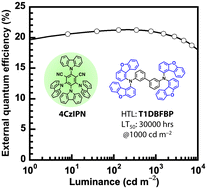Effect of substitution position of dibenzofuran-terminated robust hole-transporters on physical properties and TADF OLED performances†
Abstract
Although the wide-energy-gap hole-transport layer (HTL) is a key material to realizing high-efficiency and long-lifetime phosphorescent and thermally activated delayed fluorescent (TADF) organic light-emitting devices (OLEDs), a limited number of HTLs have been explored in previous studies. Accordingly, dibenzofuran-end-capped HTLs show promising performance in realizing a maximum external quantum efficiency (EQE) of 20% and a long lifetime of over 20 000 h at 1000 cd cm−2 in phosphorescent and TADF OLEDs. This study investigates the effects of the substitution positions of TnDBFBP (n = 1–4) derivatives with four DBF-end-capping groups to extensively study the molecular design of robust multifunctional HTLs. TnDBFBP derivatives exhibited a high glass transition temperature (Tg) of ∼149 °C, a triplet energy (ET) value of ∼2.9 eV, and anionic bond dissociation energy of ∼1.75 eV depending on the substitution positions. Consequently, T1DBFBP realized green TADF OLEDs with an EQE of over 20% and an operational lifetime of 50% of the initial luminance (LT50) of 30 000 h at 1000 cd m−2. These performances are among the best reported by previous studies.



 Please wait while we load your content...
Please wait while we load your content...
